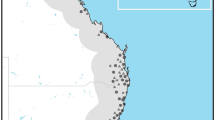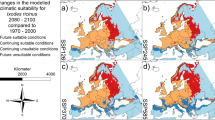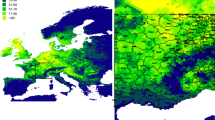Abstract
Ticks spend most of their life cycle in the environment, and all tick life cycle stages are dependent on a complex combination of climate variables. Furthermore, host availability and vegetation significantly modulate the dynamics of tick populations. Tick recruitment is dependent on successful reproduction, which in turn requires sufficient adult tick densities, available blood meal sources, and egg survival. Though many animals can serve as hosts, there are several determinants of host suitability. For example, host availability in time and space is an important determinant of tick bionomics. Shelter and protection from environmental extremes are critical to tick survival. Questing and diapausing ticks are vulnerable to extremes of temperature and humidity. There are concerns about how predicted climate change may alter several critical features of host–parasite relationships of ticks, the potential for invasion of new areas or alteration of patterns of pathogen transmission in particular. However, modeling approaches that relate known occurrences of tick species to climate (and/or landscape) features and predict geographic occurrences are not completely fulfilling our needs to understand how the “tick panorama” can change as a consequence of these climate trends. This is a short review about the concept of ecological niche as applied to ticks, as well as some raised concerns about its evaluation and strict definition, and its usefulness to map geographical suitability for ticks. Comments about how climate, hosts, and landscape configuration are briefly discussed regarding its applicability to tick mapping and with reference about their impact on tick abundance. I will further comment on already published observations about observed changes in the geographical range of ticks in parts of Europe.





Similar content being viewed by others
References
Araújo MB, Thuiller W, Williams PH, Reginster I (2005) Downscaling European species atlas distributions to a finer resolution; implications for conservation planning. Glob Ecol Biogeogr 14:17–30
Austin MP (2002) Spatial prediction of species distribution: an interface between ecological theory and statistical modelling. Ecol Model 157:101–118
Cumming GS (2000) Using between-model comparisons to fine-tune linear models of species ranges. J Biogeogr 27:441–445
Daniel M, Danielova V, Kriz B, Jirsa A, Nozicka J (2003) Shift of the tick Ixodes ricinus and tick-borne encephalitis to higher altitudes in Central Europe. Eur J Clin Microbiol Infect Dis 22:327–328
Danielova V, Holubova J, Daniel M (2002) Tick-borne encephalitis virus prevalence in Ixodes ricinus ticks collected in high risk habitats of the South-Bohemian region of the Czech Republic. Exp Appl Acarol 26:145–151
Dautel H, Dippel C, Oehme R, Hartelt K, Schettler E (2006) Evidence for an increased geographical distribution of Dermacentor reticulatus and detection of Rickettsia sp. RpA4. Int J Med Microbiol 296:149–156
Doledec S, Chessel D, Gimaret-Carpentier C (2000) Niche separation in community analysis: a new method. Ecology 81:2914–2927
Ergonul O, Celikbas A, Dokuzoguz B, Eren S, Baykam N, Esener H (2004) The characteristics of Crimean-Congo hemorrhagic fever in a recent outbreak in Turkey and the impact of oral ribavirin therapy. Clin Infect Dis 39:285–289
Estrada-Peña A (2003) The relationships between habitat topology, critical scales of connectivity and tick abundance of Ixodes ricinus in a heterogeneous landscape in northern Spain. Ecography 26:661–671
Estrada-Peña A, Venzal JM (2006) Changes in habitat suitability for the tick Ixodes ricinus (Acari: Ixodidae) in Europe (1900–1999). Ecohealth 3:154–162
Estrada-Peña A, Venzal JM (2007) Climate niches of tick species in the Mediterranean region: modelling of occurrence data, distributional constraints, and impact of climate change. J Med Entomol 44:1130–1138
Estrada-Peña A, Gray JS, Kahl O (1996) Variability in cuticular hydrocarbons and phenotypic discrimination of Ixodes ricinus populations (Acarina: Ixodidae) from Europe. Exp Appl Acarol 20:457–467
Estrada-Peña A, Martínez JM, Sánchez-Acedo C, Quílez J, Del Cacho E (2004) Phenology of the tick, Ixodes ricinus, in the southern distribution range (central Spain). Med Vet Entomol 18:387–397
Estrada-Peña A, Bouattour A, Camicas J-L, Guglielmone A, Horak I, Jongejan F, Latif AA, Pegram R, Walker AR (2006a) The known distribution and ecological preferences of the ticks subgenus Boophilus (Acari: Ixodidae) in Africa and Latin America. Exp Appl Acarol 38:219–235
Estrada-Peña A, Venzal JM, Sánchez Acedo C (2006b) The tick Ixodes ricinus: distribution and climate preferences in the western Palaearctic. Med Vet Entomol 20:189–197
Estrada-Peña A, Pegram R, Barre N (2007) Using invaded range data to model climate suitability for Amblyomma variegatum (Acari: Ixodidae) in the New World. Exp Appl Acarol 41:203–214
Gray JS (2002) Biology of Ixodes species in relation to tick-borne zoonoses. Wien Klin Wochenschr 114:473–478
Guisan A, Zimmermann NE (2000) Predictive habitat distribution models in ecology. Ecol Model 135:147–186
Hugh-Jones M (1989) Applications of remote sensing to the identification of habitats of parasites and diseases vectors. Parasitol Today 5:244–251
Lindgren E, Talleklint L, Polfeldt T (2000) Impact of climatic change on the northern latitude limit and population density of the disease-transmitting European tick Ixodes ricinus. Environ Health Perspect 108:119–123
Lobo J (2007) More complex distribution models or more representative data? Biodiv Informatics 4:1–6
Lockwood JL, Cassey P, Blackburn T (2005) The role of the propagule pressure in explaining species invasion. Trends Ecol Evol 20:223–228
Materna J, Daniel M, Danielova V (2005) Altitudinal distribution limit of the tick Ixodes ricinus shifted considerably towards higher altitudes in Central Europe: results of three years monitoring in the Krkonose Mts. (Czech Republic). Cent Eur J Public Health 13:24–28
McPheron JM, Jetz W, Rogers DJ (2006) Using coarse-grained occurrence data to predict species distributions at finer spatial resolutions—possibilities and limitations. Ecol Model 192:499–522
Nijhof A, Bodaan C, Postigo M, Nieuwenhuijs H, Opsteegh M, Franssen L, Jebbink F, Jongejan F (2007) Ticks and associated pathogens from domestic animals in the Netherlands. Vector Borne Zoonotic Dis 7:585–596
Osborne P, Suárez-Seoane S (2002) Should data be partitioned spatially before building large scale distribution models? Ecol Model 157:249–259
Peterson AT, Holt RD (2003) Niche differentiation in Mexican birds: using point occurrences to detect ecological innovation. Ecol Lett 6:774–782
Peterson AT (2006) Uses and requirements of ecological niche models and related distributional models. Biodiv Informatics 3:59–72
Prinzing A, Durka W, Klotz S (2002) Geographic variability of ecological niches of plant species: are competition and stress relevant? Ecography 25:721–729
Randolph SE, Green RM, Hoodless AN, Peacey MF (2002) An empirical quantitative framework for the seasonal population dynamics of the tick Ixodes ricinus. Int J Parasitol 32:979–989
Schoener TW (1989) The ecological niche. In: Cherret J (ed) Ecological concepts: the contribution of ecology to an understanding of the natural world. Blackwell Scientific, Oxford, pp 790–813
Skarpaas T, Ljøstad U, Sundøy A (2004) First human cases of tickborne encephalitis, Norway. Emerg Infect Dis 10:2241–2243
Skarphedinsson S, Jensen PM, Kristiansen K (2005) Survey of tickborne infections in Denmark. Emerg Infect Dis 11:1055–1061
Talleklint L, Jaenson TG (1998) Increasing geographical distribution and density of Ixodes ricinus (Acari: Ixodidae) in central and northern Sweden. J Med Entomol 35:521–526
Thuiller W, Lavorel S, Araújo M (2005) Niche properties and geographical extent as predictors of species sensitivity to climate change. Glob Ecol Biogeogr 14:347–357
Thuiller W, Mifgley GF, Hughes GO, Bomhard B, Drew G, Rutherford MC, Woodward FI (2006) Endemic species and ecosystem sensitivity to climate change in Namibia. Glob Chang Biol 12:759–776
Author information
Authors and Affiliations
Corresponding author
Rights and permissions
About this article
Cite this article
Estrada-Peña, A. Climate, niche, ticks, and models: what they are and how we should interpret them. Parasitol Res 103 (Suppl 1), 87–95 (2008). https://doi.org/10.1007/s00436-008-1056-7
Received:
Accepted:
Published:
Issue Date:
DOI: https://doi.org/10.1007/s00436-008-1056-7




